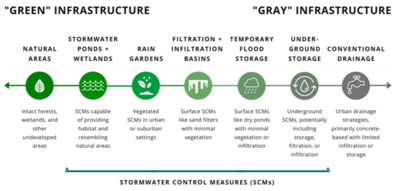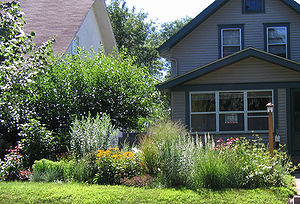
Difference between revisions of "Green Stormwater Infrastructure (GSI) and sustainable stormwater management"
m |
|||
| Line 8: | Line 8: | ||
{{alert|Throughout this manual, these green alert boxes identify practices and concepts related to green infrastructure.|alert-success}} | {{alert|Throughout this manual, these green alert boxes identify practices and concepts related to green infrastructure.|alert-success}} | ||
| − | <span title="Green | + | <span title="Green Infrastructure refers to ecological systems, both natural and engineered, that act as living infrastructure. Green Infrastructure elements are planned and managed primarily for stormwater control, but also exhibit social, economic and environmental benefits (Syracuse University)."> '''Green infrastructure'''</span> encompasses a wide array of practices, including stormwater management. <span title="Green stormwater infrastructure (GSI) describes practices that use natural systems (or engineered systems that mimic or use natural processes) to capture, clean, and infiltrate stormwater; shade and cool surfaces and buildings; reduce flooding, create wildlife habitat; and provide other services that improve environmental quality and communities’ quality of life. (City of Tucson)"> '''Green stormwater infrastructure'''</span> (GSI) encompasses a variety of practices primarily designed for managing stormwater runoff but that provide additional benefits such as habitat or aesthetic value. |
Water management using green infrastructure practices mimics the natural <span title="The water cycle, also known as the hydrologic cycle or the hydrological cycle, describes the continuous movement of water on, above and below the surface of the Earth."> '''water cycle'''</span>. Examples of green infrastructure practices include planting trees, restoring wetlands, enhancing biodiversity, and restoring floodplains. Green infrastructure incorporates both the natural environment and engineered systems to provide clean water, conserve <span title="Ecosystem values are measures of how important ecosystem services, such as pollination, nutrient cycling, and climate regulation, are to people – what they are worth."> '''ecosystem values'''</span> and functions, and provide a wide array of benefits to people and wildlife. Green infrastructure can be applied on different scales, from the house or building level, to the broader landscape level. On the local level, green infrastructure practices include rain gardens, permeable pavements, green roofs, infiltration planters, trees and tree boxes, and rainwater harvesting systems. At the largest scale, the preservation and restoration of natural landscapes (such as forests, floodplains and wetlands) are critical components of green infrastructure. | Water management using green infrastructure practices mimics the natural <span title="The water cycle, also known as the hydrologic cycle or the hydrological cycle, describes the continuous movement of water on, above and below the surface of the Earth."> '''water cycle'''</span>. Examples of green infrastructure practices include planting trees, restoring wetlands, enhancing biodiversity, and restoring floodplains. Green infrastructure incorporates both the natural environment and engineered systems to provide clean water, conserve <span title="Ecosystem values are measures of how important ecosystem services, such as pollination, nutrient cycling, and climate regulation, are to people – what they are worth."> '''ecosystem values'''</span> and functions, and provide a wide array of benefits to people and wildlife. Green infrastructure can be applied on different scales, from the house or building level, to the broader landscape level. On the local level, green infrastructure practices include rain gardens, permeable pavements, green roofs, infiltration planters, trees and tree boxes, and rainwater harvesting systems. At the largest scale, the preservation and restoration of natural landscapes (such as forests, floodplains and wetlands) are critical components of green infrastructure. | ||
Revision as of 12:21, 9 June 2022


Green infrastructure encompasses a wide array of practices, including stormwater management. Green stormwater infrastructure (GSI) encompasses a variety of practices primarily designed for managing stormwater runoff but that provide additional benefits such as habitat or aesthetic value.
Water management using green infrastructure practices mimics the natural water cycle. Examples of green infrastructure practices include planting trees, restoring wetlands, enhancing biodiversity, and restoring floodplains. Green infrastructure incorporates both the natural environment and engineered systems to provide clean water, conserve ecosystem values and functions, and provide a wide array of benefits to people and wildlife. Green infrastructure can be applied on different scales, from the house or building level, to the broader landscape level. On the local level, green infrastructure practices include rain gardens, permeable pavements, green roofs, infiltration planters, trees and tree boxes, and rainwater harvesting systems. At the largest scale, the preservation and restoration of natural landscapes (such as forests, floodplains and wetlands) are critical components of green infrastructure.
Stormwater management using green infrastructure practices involves keeping and using water close to its point of origin (i.e. keeping the raindrop where it falls). Practices include those local practices mentioned above - rain gardens, permeable pavements, green roofs, infiltration planters, trees and tree boxes, and rainwater harvesting systems. Because there multiple benefits of these practices, in addition to stormwater management, the manual includes a variety of topics related to green infrastructure as illustrated below.
This page provides links to information on green stormwater infrastructure, green infrastructure, and sustainable stormwater management.
Green stormwater infrastructure and sustainable stormwater management
- Overview for green stormwater infrastructure - Comment
- Green infrastructure and green stormwater infrastructure terminology
- Overview for sustainable stormwater management - Comment
- Planning green stormwater infrastructure projects and practices - Comment
- Training and certification for green stormwater infrastructure - Comment
Green stormwater infrastructure best management practices
- Green stormwater infrastructure best management practices
- Design considerations for green stormwater infrastructure best management practices - comment
- Operation and maintenance of green stormwater infrastructure best management practices
- Assessing the performance of green stormwater infrastructure best management practices - comment
- Multiple benefits of green stormwater infrastructure
